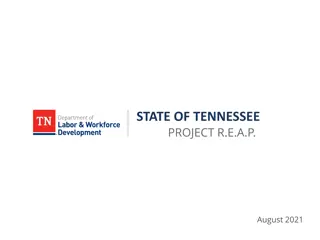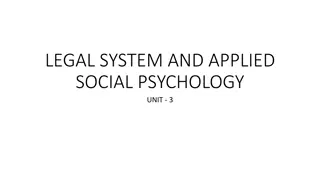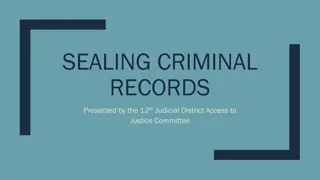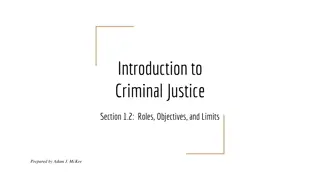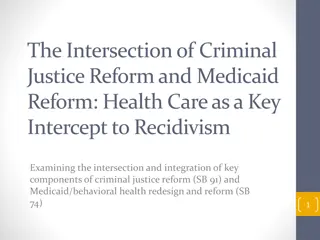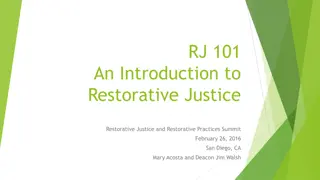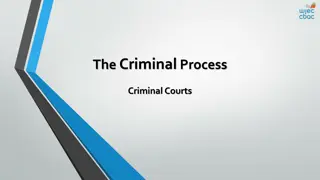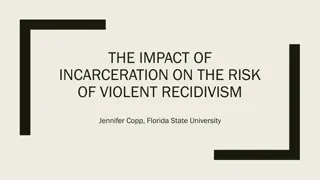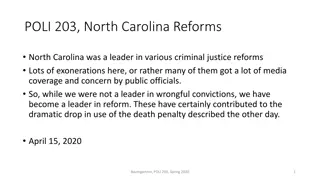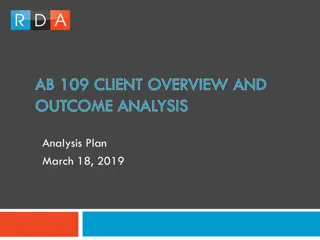Understanding Recidivism Measurement in Criminal Justice Policy
Recidivism, a key measurement in criminal justice policy, is crucial for assessing the effectiveness of rehabilitation schemes over time. This content delves into the challenges of measuring recidivism, different country definitions, the importance of studying recidivism, factors influencing recidivism rates, and the need to integrate various data sources for a comprehensive analysis. It highlights the benefits of studying recidivism, such as identifying at-risk populations and making informed decisions for effective policy-making.
Download Presentation

Please find below an Image/Link to download the presentation.
The content on the website is provided AS IS for your information and personal use only. It may not be sold, licensed, or shared on other websites without obtaining consent from the author. Download presentation by click this link. If you encounter any issues during the download, it is possible that the publisher has removed the file from their server.
E N D
Presentation Transcript
Crime Section, Central Statistics Office. 1
The Policy Question The Challenge to measuring recidivism The Initial State of Affairs The Benefits of linkage. The matching process The results The Policy Question The Challenge to measuring recidivism The Initial State of Affairs The Benefits of linkage. The matching process The results 2
What is the Rate of Recidivism? Recidivism is a measure of re is a key measurement for criminal justice policy. What is the Rate of Recidivism? Recidivism is a measure of re- -offending rates and is a key measurement for criminal justice policy. offending rates and Different definitions in different countries Different definitions in different countries Irish formal definition: Probation/Prison Service: an individual who committed a recorded offence within released from Prison); and who is convicted in court proceedings that commenced within two years of the offence Irish formal definition: Probation/Prison Service: A recidivist (re an individual who committed a recorded offence within three years released from Prison); and who is convicted in court proceedings that commenced within two years of the offence A recidivist (re- -offender) is offender) is three years of commencing probation (or being of commencing probation (or being 3
Why is recidivism important? Allows measurement of effectiveness of rehabilitation schemes over time Why is recidivism important? Allows measurement of effectiveness of rehabilitation schemes over time Determines factors that lead to higher/lower recidivism rates Determines factors that lead to higher/lower recidivism rates Identify populations prone to recidivism E.g. the under 25s. Value for money from informed decision making Identify populations prone to recidivism E.g. the under 25s. Value for money from informed decision making 4
How to define recidivism There is a need to integrate Garda, Probation and Prison data. There is no common identifier between the datasets CSO uses a matching methodology to link these separate datasets. 5
Permits the study of recidivism. Extremely low cost no surveys required Results can be generated on a frequent (annual) basis Leads to comprehensive statistics studying the entire populations of interest. 7
Probation and Prison datasets used to develop a matching algorithm Complex, lengthy process no common identifier Use of first names/surnames/dates of birth Difficulties in linking the datasets 9
This matching process had some additional complexities. Large datasets. Intentional errors (by offenders) in names and age addressed by methodology. A success, with 95% of individuals matched. 10
Development of complex linking algorithm Reliable and accurate recidivism figures were produced Analysis by age, sex, initial and subsequent offence. Statistics can be produced cheaply, quickly. New policy outcome indicators for Justice 11
Probation Recidivism Results Selected results for 2007 and 2008 Table 1 Offender numbers classified by sex, age group, probation type, probation referral offence and whether there was a re- offence within three years, 2008 and 2009 cohort 2008 cohort 2009 cohort Recidivis m1 Recidivis m Re-offence within three years Re-offence within three years Recidivism rate rate rate Absolute change Yes No Total % Yes No Total % Total offenders 41.0 37.3 -3.8 1,543 2,218 3,761 1,436 2,418 3,854 Sex Male 1,373 1,888 3,261 42.1 1,279 2,059 3,338 38.3 -3.8 Female 170 330 500 34.0 157 359 516 30.4 -3.6 12
Data linkage can be possible even with absence of common identifiers Including where errors in linking fields Data linkage can produce quick, cheap and reliable measures of urgent public policy questions. If common identifiers such as PPSN are included in future, more analysis possible. 13



